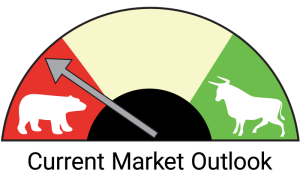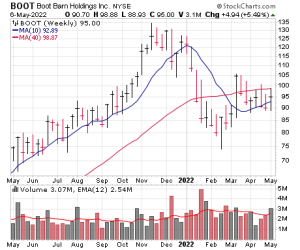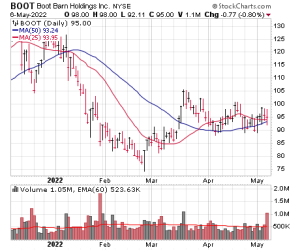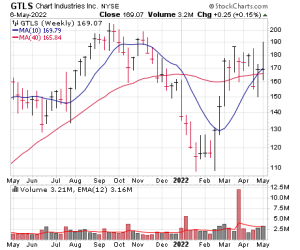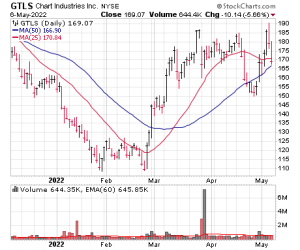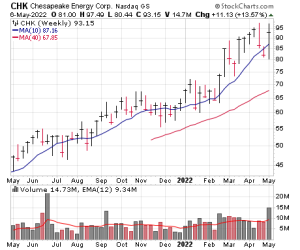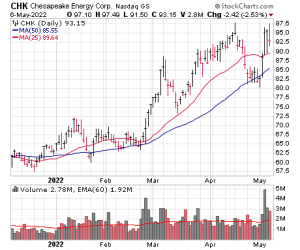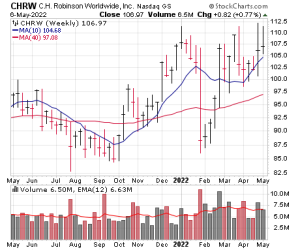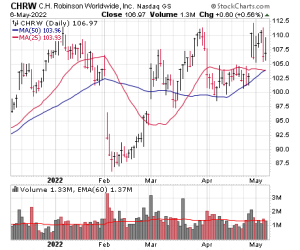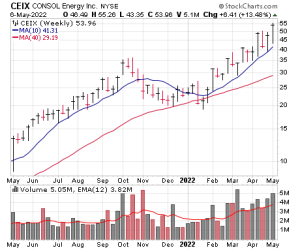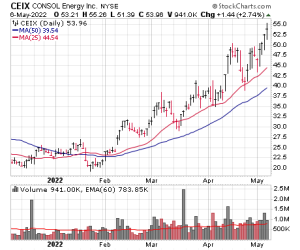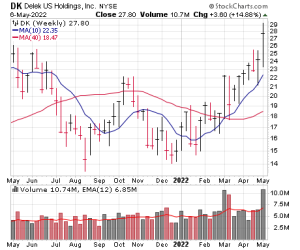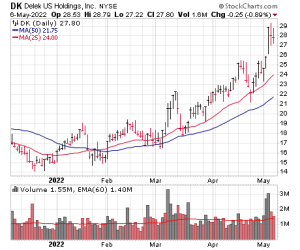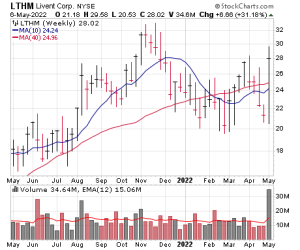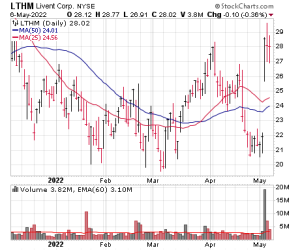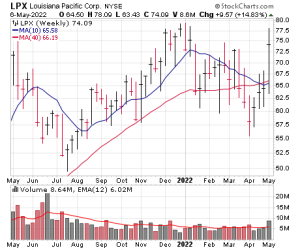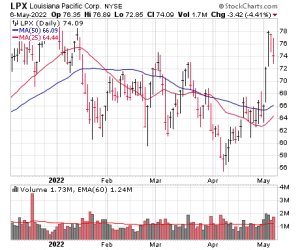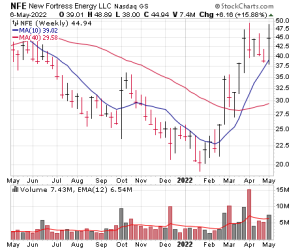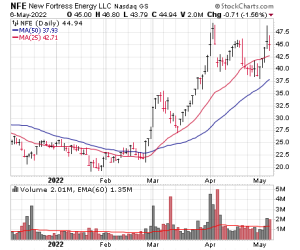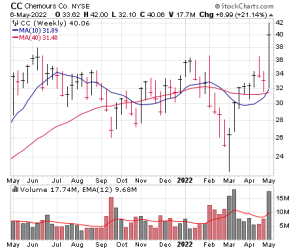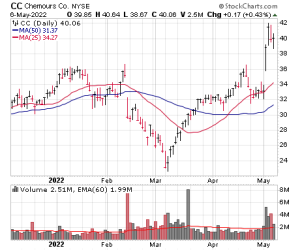Today was another day of bloodletting, with the major indexes and many former leaders continuing to melt down. Short-term, there’s little doubt things are getting emotional—thus, it’s certainly possible we’re close to a low point, but of course you could have said that a few days ago as well. As always, you shouldn’t fight the tape—with most things cratering, you should be holding much more cash than stocks, though we’re still not opposed to a nibble here or there. When this maelstrom is over, there are going to be some great buying opportunities, but right now, you should remain defensive. Our Market Monitor is down to a level 2.
This week’s list is heavy on commodity names, which did get hit today but in general remain in uptrends. Our Top Pick is a refining name that has recently shown accelerating strength.
Cabot Top Ten Trader Issue: May 9, 2022
Don’t Fight the Tape (but Keep Your Eyes Open)
Today was another day of bloodletting, with the major indexes gapping lower at the open, with many former leaders continuing to melt down and with even some resilient areas of the market (like energy stocks) taking good-sized hits. Short-term, there’s little doubt things are getting emotional—whether it’s forced or panic selling, we’re seeing stocks implode a few percent at a clip, while many internal metrics (new highs vs new lows, etc.) are at levels rarely seen. Thus, it’s certainly possible we’re close to a low point, but of course you could have said that a few days ago as well. As always, you shouldn’t fight the tape—with most things in meltdown mode, you should be holding much more cash than stocks, though keeping your eyes open for a turn makes sense; we’re still not opposed to a nibble here or there in strong stocks and sectors as they pull in to support. When this maelstrom is over, there are going to be some great buying opportunities, but right now, you should remain defensive. Our Market Monitor is down to a level 2.
This week’s list is heavy on commodity names, which did get hit today but in general remain in uptrends. Our Top Pick is Delek (DK), part of the refining group that’s recently turned strong, and the latest weakness looks normal.
| Stock Name | Price | Buy Range | Loss Limit |
| Boot Barn (BOOT) | 87 | 84-88 | 74-76 |
| Chart Industries (GTLS) | 162 | 158-163 | 140-143 |
| Chesapeake Energy (CHK) | 84 | 82.5-85.5 | 73-75 |
| CH Robinson (CHRW) | 108 | 105-108 | 97-99 |
| Consol Energy (CEIX) | 48 | 44-46.5 | 38.5-40.5 |
| Delek (DK) ★ TOP PICK ★ | 24 | 23-25 | 20.5-21.5 |
| Livent (LTHM) | 24 | 23.5-25 | 20-21 |
| Louisiana Pacific (LPX) | 74 | 71-74 | 65-67 |
| New Fortress Energy (NFE) | 41 | 39-41 | 34-35 |
| The Chemours Co. (CC) | 39 | 37-39 | 33-34 |
Stock 1
Boot Barn (BOOT)
| Price | Buy Range | Loss Limit |
| 87 | 84-88 | 74-76 |
Why the Strength
Boot Barn has always had a very solid niche story, selling country-style hats, boots, clothes and blue-collar workwear (all of which are seeing growing demand over time and usually see few price discounts), and with the pandemic (mostly) in the rear-view mirror and with energy-related firms doing well, business has enjoyed an excellent rebound in recent quarters. But this looks like more than just a big-picture turnaround play—Boot Barn’s management has put a lot of time and money into expanding and modernizing its offerings (some dresses, ball caps, hiking boots, knit shirts, etc.) and focused on exclusive brands, with the result being that the firm has expanded its appeal beyond the traditional western customer; indeed, apparel and western boots for women were among the firm’s strongest categories in the latest quarter. Throw in a solid cookie-cutter aspect here (store growth of around 10% annually; stores opened since March 2020 have paid back the initial investment in just one year!) and the overall results have been eye-opening: In the quarter ended December, sales rose 71% from two years ago (pre-pandemic quarter), with same-store sales up 61% from that period and earnings more than doubling. Most expect growth to slow, with fiscal 2023 (which started April 1 of this year) earnings slipping 10% after last year’s moonshot, but we think there’s a chance that will prove very conservative. The facts will be revealed tomorrow night (May 10), when fiscal Q4 results will be released.
Technical Analysis
BOOT had an unbelievable run not just from its pandemic lows but all through last year, with the 10-week line offering support; shares finally blew off on the upside in November, which along with the sour market, led to a 45% retreat by February. However, the stock rallied nicely for a month after that, and it’s been resilient since, setting up a reasonable consolidation heading into earnings. If you want to roll the dice, you could nibble ahead of tomorrow night’s report, though we prefer to just watch it and see what earnings brings.
| Market Cap | $2.79B | EPS $ Annual (Mar) | |
| Forward P/E | 16 | FY 2020 | 1.55 |
| Current P/E | 18 | FY 2021 | 1.93 |
| Annual Revenue | $1.36B | FY 2022e | 6.14 |
| Profit Margin | 12.4% | FY 2023e | 5.53 |
| Qtrly Rev | Qtrly Rev Growth | Qtrly EPS | Qtrly EPS Growth | |
| ($M) | (vs. yr-ago-qtr) | ($) | (vs.yr-ago-qtr) | |
| Latest qtr | 486 | 61% | 2.23 | 125% |
| One qtr ago | 313 | 69% | 1.22 | 510% |
| Two qtrs ago | 306 | 107% | 1.26 | N/A |
| Three qtrs ago | 259 | 37% | 0.75 | 317% |
Weekly Chart | Daily Chart |
Stock 2
Chart Industries (GTLS)
| Price | Buy Range | Loss Limit |
| 162 | 158-163 | 140-143 |
Why the Strength
Chart is a leading maker of equipment used in the clean energy and industrial gas markets, and its products are used in every phase of the liquid gas supply chain. Supply issues in the oil market due to the Russia/Ukraine war gave Chart’s liquified natural gas (LNG) operations and energy solutions a major boost in Q1, as LNG demand has dramatically increased in recent months. Revenue of $354 million set a new first-quarter record and was 23% higher than a year ago, while per-share earnings of 65 cents beat expectations by 10 cents. Q1 also included Chart’s sixth straight quarter of record backlog (amounting to $1.5 billion) and its highest ever quarter of total orders—up and eye-popping 53%. It wasn’t just LNG products that were in high demand, however, as the firm’s cryo tank solutions, specialty products and heat transfer systems saw their backlog rise 49%, 55% and 77%, respectively. Indeed, Chart isn’t hanging its hat on LNG alone; the company completed a slew of acquisitions in 2020 and 2021 that will provide more exposure to the burgeoning clean energy business. These include Sustainable Energy Solutions, which boasts a post-combustion technology that reduces carbon emissions from coal-powered power plants by up to 99%, and at a lower cost than other carbon capture systems. Chart also has a stake in sustainable chemical technology outfit Transform Materials, which converts natural gas into acetylene and hydrogen via a net carbon-negative process. The big picture looks very bullish—not only does the top brass see free cash flow of $5.50 this year, but at last week’s Investor Day, it revealed that it sees revenues growing 17%-plus annually and earnings 25%-plus annually for the next three years even as debt is paid off.
Technical Analysis
GTLS spent the first seven months of last year locked in a holding pattern between 120 and 165, and while it did briefly break higher, the stock eventually hit a ceiling at 200 in September—and soon got caught up in the market’s undertow, falling about 45% by January. However, GTLS actually tightened up at that point and recovered most of the lost ground by the end of March, with the stock gyrating in the past few weeks. We’d like to see it settle down a bit, but if you want in, nibbling on this dip could work.
| Market Cap | $6.17B | EPS $ Annual (Dec) | |
| Forward P/E | 33 | FY 2020 | 2.41 |
| Current P/E | 68 | FY 2021 | 2.72 |
| Annual Revenue | $1.38B | FY 2022e | 5.17 |
| Profit Margin | 9.6% | FY 2023e | 8.02 |
| Qtrly Rev | Qtrly Rev Growth | Qtrly EPS | Qtrly EPS Growth | |
| ($M) | (vs. yr-ago-qtr) | ($) | (vs.yr-ago-qtr) | |
| Latest qtr | 354 | 23% | 0.65 | -12% |
| One qtr ago | 379 | 21% | 0.73 | -20% |
| Two qtrs ago | 328 | 20% | 0.49 | -22% |
| Three qtrs ago | 322 | 11% | 0.76 | 69% |
Weekly Chart | Daily Chart |
Stock 3
Chesapeake Energy (CHK)
| Price | Buy Range | Loss Limit |
| 84 | 82.5-85.5 | 73-75 |
Why the Strength
After a spate of quarterly reports, it’s clear that the fundamental energy story is very much intact, and while there are more than a few attractive oil plays, the best opportunities may be in natural gas—that area had a longer, deeper dry spell, leading to far more cost and capacity cuts, and the sea change in Europe and acceptability of natural gas as carbon-friendly (at least compared to coal) could mean a new era of higher prices has just begun. Chesapeake is a gas-heavy player in the Marcellus (about 45% of production this year), Haynesville (~40%) and Eagle Ford (15%-ish), and it’s following the new playbook of mostly constrained CapEx, though it is upping output in certain places (Haynesville up 10% this year). Even so, the net result is gigantic cash flows: Even with a bunch of hedges (71% of gas and 58% of oil is hedged for the remainder of the year), the firm saw free cash flow come in around $4.50 per share in Q1, which (between its base 50 cent quarterly dividend and a variable payout) led to a quarterly $2.34 per share dividend. And there should be plenty more where that came from—even in mid February, when gas prices were in the $4.70 range, Chesapeake anticipated paying out around $8.40 per share in dividends this year, and that figure could lift to $10 or more based on current strip prices. There’s also a good-sized buyback program ($1 billion through year-end 2023) that management said has “a good chance of being exhausted early,” while the top brass also said reducing debt (which is already well under 1x cash flow) isn’t a huge priority at this point. It’s a good story that, importantly, should remain buoyant even if energy prices correct further.
Technical Analysis
Despite having a cash flow profile as solid as any in its group, CHK has been a bit herky-jerky since breaking out in February: There was an excellent run on big volume on the initial breakout, followed by a sharp dip (89 to 73), and the next ramp to new highs also saw a good-sized pothole (97 to 80). But the 50-day line offered support last week and shares are still above their recent lows even after today’s market-induced plunge. We’re OK taking a swing at CHK here, but keep it small and use a loose leash.
| Market Cap | $11.0B | EPS $ Annual (Dec) | |
| Forward P/E | 8 | FY 2020 | 19.34 |
| Current P/E | 10 | FY 2021 | 33.47 |
| Annual Revenue | $5.60B | FY 2022e | 11.89 |
| Profit Margin | 46.6% | FY 2023e | 13.18 |
| Qtrly Rev | Qtrly Rev Growth | Qtrly EPS | Qtrly EPS Growth | |
| ($M) | (vs. yr-ago-qtr) | ($) | (vs.yr-ago-qtr) | |
| Latest qtr | 935 | -18% | 3.09 | -89% |
| One qtr ago | 3086 | 147% | 2.39 | -79% |
| Two qtrs ago | 890 | -7% | 2.38 | -53% |
| Three qtrs ago | 693 | 37% | 1.64 | -93% |
Weekly Chart | Daily Chart |
Stock 4
CH Robinson (CHRW)
| Price | Buy Range | Loss Limit |
| 108 | 105-108 | 97-99 |
Why the Strength
Supply chain snafus and still-strong consumer demand means logistics efforts are more important to the flow of trade than they normally are. CH Robinson is one of the world’s largest global logistics platforms, that is, it’s a broker between shippers and truckers and their customers, serving more than 100,000 clients who should generate some $25.7 billion in revenue this year. CH Robinson has managed the double-edged sword of supply chain troubles well. Typically, customers book shipping capacity under contracts (usually a year long) through the company. Robinson has a clause that allows it to reprice rates partially in response to the market, so the company has been able to hike prices on the fuel costs of its contracted carriers (half its business is in North American trucking) while maintaining favorable pricing power with transportation customers because of its heft. In Q1, reported April 27, the company bested consensus earnings by 50 cents, at $2.05 a share on a revenue surge of 42%, to $6.8 billion, also handily over Wall Street’s expectations. Robinson has built a software system that allows it to recognize changes in rates and pass along the adjustments to customers, as well as book more profitable options, more quickly. Its Navisphere Carrier platform provides customers with real-time rates and the ability to book capacity themselves, without speaking to a Robinson agent; fully automated business more than doubled last year to $831 million of bookings. Investors are also thinking bullishly after Ancora, an activist fund that specializes in transportation companies, wrangled two seats on the board in February. That implies moves toward creating greater shareholder value should be ahead. In the meantime, business is good and the stock isn’t very pricey (15x earnings, 2.1% dividend).
Technical Analysis
CHRW peaked near the start of 2021 and hasn’t done anything since, suffering through a bunch of 20%-ish corrections during that time. But (a) the stock has perked up since early February and actually held its gains despite a meltdown in the market and transport stocks, and (b) shares did react well to the Q1 report, though of course CHRW is still having trouble at its prior highs near 112. It’s fine to keep an eye on, and if you want in, you could start a position of CHRW here or on dips.
| Market Cap | $13.8B | EPS $ Annual (Dec) | |
| Forward P/E | 15 | FY 2020 | 3.72 |
| Current P/E | 15 | FY 2021 | 6.31 |
| Annual Revenue | $25.1B | FY 2022e | 7.33 |
| Profit Margin | 3.5% | FY 2023e | 6.21 |
| Qtrly Rev | Qtrly Rev Growth | Qtrly EPS | Qtrly EPS Growth | |
| ($M) | (vs. yr-ago-qtr) | ($) | (vs.yr-ago-qtr) | |
| Latest qtr | 6.82 | 42% | 2.05 | 60% |
| One qtr ago | 6.5 | 43% | 1.74 | 61% |
| Two qtrs ago | 6.26 | 48% | 1.85 | 85% |
| Three qtrs ago | 5.53 | 53% | 1.44 | 36% |
Weekly Chart | Daily Chart |
Stock 5
Consol Energy (CEIX)
| Price | Buy Range | Loss Limit |
| 48 | 44-46.5 | 38.5-40.5 |
Why the Strength
While the developed world is trying to become less dependent on fossil fuels like coal, the war in Ukraine has put that mineral back in the spotlight due to elevated natural gas costs. Consol is a Pennsylvania-based producer and exporter of high-BTU bituminous thermal and metallurgical coal, and as one of the leading energy companies in the U.S., it’s in an excellent position to benefit from the renewed coal boom. Coal sales in Q1 increased 5% from a year ago, to $359 million, and while per-share earnings missed expectations, investors see huge earnings ahead. Coal shipments out of the firm’s Pennsylvania Mining Complex amounted to 6.5 million tons, down 6% from a year ago but up 16% from the prior quarter. Throughput volumes at the company’s marine terminal in Q1 were down 12% from last year, but also up 16% sequentially, resulting in record revenue for the segment. But what really captured Wall Street’s attention was the company’s reported free cash flow of $118 million (about $3.30 per share!), which increased 61% from a year ago and soared a whopping 372% from Q4 (a reason for the strength). Management expects the supply tightness that has characterized the coal market since early 2021 to continue due to the ongoing Ukraine/Russia war, and its contracted position for 2023 has subsequently improved to over 16 million tons—a substantial improvement from a year ago. The company also updated the progress of its Itmann, West Virginia mine, which remains on track to produce around half a million tons of coal in the second half of 2022. Going forward, the numbers look gigantic through at least next year, with earnings of $9 and $18 per share this year and next.
Technical Analysis
CEIX had a huge post-vaccine rally that took the stock to 35 in October, when a deep correction unfolded; shares were nearly cut in half through January and it was thought that the stock was done for. But the European war gave CEIX a new lease on life, with cash flow and earnings estimates going through the roof, pushing shares sharply higher (albeit with tons of short-term volatility). The 25-day line has contained the advance, dips of another couple of points would be tempting.
| Market Cap | $1.86B | EPS $ Annual (Dec) | |
| Forward P/E | 6 | FY 2020 | -0.37 |
| Current P/E | N/A | FY 2021 | 0.96 |
| Annual Revenue | $1.28B | FY 2022e | 8.97 |
| Profit Margin | 24.4% | FY 2023e | 17.85 |
| Qtrly Rev | Qtrly Rev Growth | Qtrly EPS | Qtrly EPS Growth | |
| ($M) | (vs. yr-ago-qtr) | ($) | (vs.yr-ago-qtr) | |
| Latest qtr | 359 | 5% | -0.13 | N/A |
| One qtr ago | 481 | 48% | 3.30 | 573% |
| Two qtrs ago | 149 | -39% | -3.30 | N/A |
| Three qtrs ago | 287 | 77% | 0.12 | N/A |
Weekly Chart | Daily Chart |
Stock 6
Delek (DK) ★ Top Pick
| Price | Buy Range | Loss Limit |
| 24 | 23-25 | 20.5-21.5 |
Why the Strength
Improving demand and margins for downstream companies that refine crude oil into usable products like fuels, asphalt and lubricants has prompted a major ratings firm to predict “impressive” revenue and cash flow growth for the group this year. Delek is a diversified downstream energy company with assets in petroleum transportation and storage, asphalt, renewable fuels and even convenience stores. But refining is Delek’s specialty, as the firm is able to process 302,000 barrels per day of crude from its four U.S. refineries; refining tends to be less impacted by falling oil prices and more impacted by the spread between input costs (crude oil) and output prices (for their end product). Dramatic improvement in the refining landscape has prompted a number of Wall Street institutions to boost their outlook for margins in 2022, while Delek has expressed optimism in what it calls a “robust macro environment.” The company just released Q1 results that blew estimates out of the water (a reason for the strength), including revenue of nearly $4.5 billion that was up 86% from a year ago and EPS of 58 cents that beat expectations by 69 cents. The strong industry backdrop gave Delek the confidence to repurchase around 5% of its stock in March (!), with plans to further enhance the balance sheet and return cash to shareholders throughout the year. Further, management said it has no major planned CapEx this year, which is music to investors’ ears. The company also updated its planned acquisition of midstream company 3Bear Energy, which Delek said would allow it to achieve midstream EBITDA of around $380 million per year while increasing its reach within the resource-rich Permian Basin. Analysts see the good times continuing and predict 60% sales growth in Q2. We like it.
Technical Analysis
DK hit a major peak in mid-2018 at 60 and spent the next couple of years tumbling before reaching a nadir at 10 in October 2020. A powerful rally followed over the next four months, but this was terminated at 27 last February. DK needed most of 2021 to consolidate and build a deep base for the next phase of its bull run that finally blossomed in March and which resulted in shares hitting their highest level since 2020 last week. The dip of the past couple of days has been sharp but normal, so if you want in, you could nibble here or (preferably) on further retrenchment.
| Market Cap | $2.06B | EPS $ Annual (Dec) | |
| Forward P/E | 13 | FY 2020 | -7.43 |
| Current P/E | N/A | FY 2021 | -3.05 |
| Annual Revenue | $12.7B | FY 2022e | 2.09 |
| Profit Margin | 1.0% | FY 2023e | 1.34 |
| Qtrly Rev | Qtrly Rev Growth | Qtrly EPS | Qtrly EPS Growth | |
| ($M) | (vs. yr-ago-qtr) | ($) | (vs.yr-ago-qtr) | |
| Latest qtr | 4.46 | 86% | 0.58 | N/A |
| One qtr ago | 3.11 | 65% | -0.61 | N/A |
| Two qtrs ago | 2.96 | 43% | 0.13 | N/A |
| Three qtrs ago | 2.19 | 43% | -0.88 | N/A |
Weekly Chart | Daily Chart |
Stock 7
Livent (LTHM)
| Price | Buy Range | Loss Limit |
| 24 | 23.5-25 | 20-21 |
Why the Strength
Electric vehicle (EV) sales have likely begun a years-long boom, with industry sales expected to rise to more than 40% of annual new car sales by the end of the decade, up from 4% last year. Even if that proves too optimistic, there’s no question there’s big growth ahead, and that means lithium, the primary metal used in EV batteries, will be in increasing demand—both from greater sales but also because EVs are using more lithium per battery to provide greater range, to about 22 pounds a car now vs. nine pounds a decade ago. Livent is a pure-play lithium producer, putting the company at the heart of the EV supply chain, so it should be poised to benefit. An American company spun off from FMC in 2018, Livent has its lithium brine production facilities in Quebec and Argentina. Not all lithium is the same, with lithium hydroxide preferred for use in high-end EV batteries and other energy storage applications because of chemical properties that allow for improved battery performance and life with a lower operating temperature. Livent got about half its $420 million 2021 revenue from lithium hydroxide, with another 20% of sales coming from Lithium carbonate and lithium chloride, used for higher grade laptop batteries and EV chargers. The balance of revenue come from related specialty metals, primarily butyllithium, which feeds into many unique applications, like military alloys and industrial polymers. In Q1, reported last week, Livent soundly beat expectations, with EPS of 21 cents, seven cents better than consensus, on sales of $144 million. Basically, lithium prices are rising and Livent is seeing the results flow to its bottom line. For the year, management expects sales to be $755 to $835 million and adjusted EBITDA as high as $350 million, nearly four times prior guidance.
Technical Analysis
LTHM broke out of a nice base last August, but the rally ran into a wall when growth stocks topped in mid November, leading to a sharp 40%-ish decline by late January. But that was effectively the low, with retests in March and late April finding support in the 20 to 21 range, and then last week’s earnings report brought a huge gap up. LTHM remains volatile and took a hit today, but it’s still in decent position; you could take a small swing at it here, or just keep it on your watch list.
| Market Cap | $4.55B | EPS $ Annual (Dec) | |
| Forward P/E | 30 | FY 2020 | -0.04 |
| Current P/E | 78 | FY 2021 | 0.18 |
| Annual Revenue | $473M | FY 2022e | 0.94 |
| Profit Margin | 12.7% | FY 2023e | 1.21 |
| Qtrly Rev | Qtrly Rev Growth | Qtrly EPS | Qtrly EPS Growth | |
| ($M) | (vs. yr-ago-qtr) | ($) | (vs.yr-ago-qtr) | |
| Latest qtr | 144 | 56% | 0.21 | 950% |
| One qtr ago | 123 | 50% | 0.08 | N/A |
| Two qtrs ago | 104 | 43% | 0.03 | N/A |
| Three qtrs ago | 102 | 57% | 0.04 | N/A |
Weekly Chart | Daily Chart |
Stock 8
Louisiana Pacific (LPX)
| Price | Buy Range | Loss Limit |
| 74 | 71-74 | 65-67 |
Why the Strength
Even with mortgage rates on the rise, strong demand from first-time Millennial home buyers, coupled with the work-from-home trend, is expected to keep building product sales high this year. Louisiana-Pacific (LP) specializes in producing high-quality siding and engineered wood products, including oriented strand board (OSB)—a plywood substitute made from compressed wood wafers that’s around half the coast of traditional boards. However, exterior wood siding is where the firm sees its strongest prospects, and LP’s siding solutions revenue grew more than twice the 13% increase in U.S. single-family housing starts last year. To that end, LP is ramping up capacity in this segment, recently opening up a new siding mill in Houlton, Maine, with plans to increase siding capacity at its Sagola, Michigan plant. All in all, siding revenue broke a record in 2021 by surpassing $1 billion in annual sales, and the firm believes it can grow that business by 15% in 2022. Last week, LP announced sales and earnings beats (a reason for the strength), featuring revenue of $1.3 billion that increased 31%, adjusted EBITDA that rose 38% to its second-highest quarterly level and per-share earnings of $5.08 that crushed estimates by 45 cents. The solid results were led by OSB sales of $744 million (up 38%) and a 17% increase in siding solutions sales. Additionally, the company authorized the buyback of $600 million of its shares, bringing the total repurchase authorization to $814 million. While management expects OSB revenue in Q2 to be 7% lower sequentially, it sees siding sales jumping 20% in both Q2 and for the full year based on record demand for its SmartSide products. A modest dividend (1.2%) helps the cause.
Technical Analysis
After peaking around 75 a year ago, LPX entered what ended up being a year-long consolidation, with a tedious pullback last summer and, after retesting its old high, a vicious plunge into early April. But now LPX may want to get moving: The stock has been up four weeks in a row (market has been down all four weeks), including a strong-volume move last week. If you want to nibble here or on dips, you can.
| Market Cap | $6.36B | EPS $ Annual (Dec) | |
| Forward P/E | 5 | FY 2020 | 4.31 |
| Current P/E | 5 | FY 2021 | 13.97 |
| Annual Revenue | $4.88B | FY 2022e | 14.88 |
| Profit Margin | 32.8% | FY 2023e | 7.69 |
| Qtrly Rev | Qtrly Rev Growth | Qtrly EPS | Qtrly EPS Growth | |
| ($M) | (vs. yr-ago-qtr) | ($) | (vs.yr-ago-qtr) | |
| Latest qtr | 1.34 | 31% | 5.08 | 69% |
| One qtr ago | 0.99 | 15% | 2.24 | 11% |
| Two qtrs ago | 1.22 | 53% | 3.87 | 148% |
| Three qtrs ago | 1.33 | 142% | 4.74 | 999% |
Weekly Chart | Daily Chart |
Stock 9
New Fortress Energy (NFE)
| Price | Buy Range | Loss Limit |
| 41 | 39-41 | 34-35 |
Why the Strength
New Fortress Energy isn’t a well-known name, but it quacks like a potential new leader given the world’s new realities in the energy sector. The firm isn’t pulling oil or gas out of the ground, but instead looks like one of the leading infrastructure plays, especially when it comes to liquified natural gas: New Fortress has spent a few years building out its assets (and making acquisitions, such as that of Golar LNG partners) that’s resulted in a global network of terminals, power plants and more. There are two big attractions now: The first are FSRUs (which “re-gassify” the slushy LNG that ships carry across oceans before putting it in pipelines), which were in growing demand anyway, and now the Russia/Ukraine war is likely to drastically boost gas demand from non-Russian sources. New Energy has seven FSRUs now, with two other ships that can be converted, making up nearly 20% of the global fleet; many are on contract, but two are available, with contract rates having doubled from a year ago (likely $50 million of annual earnings from each ship deployed at today’s rates). Then there’s what management calls “Fast LNG,” where New Fortress effectively constructs an offshore LNG terminal using new techniques that make it cheaper and (of course) faster to build; it’s filed to bring on new capacity off the coast of Louisiana, with applications for some offshore Texas to follow suit. All told, if/when approved, these will be some of the only major LNG capacity additions in the U.S. for the next few years. Long story short, the company is becoming a fully integrated gas infrastructure outfit, and there are plenty of near-term catalysts that should keep sales and earnings (see tables below) kiting higher. It’s an intriguing new story.
Technical Analysis
NFE had a big post-pandemic rally, but after topping early last year, shares went back in the soup, losing nearly two-thirds of their value into the late-January market low point. However, NFE changed character after the Russian invasion, going bananas in March before it finally hit a wall in early April. The month-long rest found support at the 10-week line, and last week’s earnings report brought in some buyers. A small buy on today’s dip is fine as long as you use a stop under the 50-day line.
| Market Cap | $9.30B | EPS $ Annual (Dec) | |
| Forward P/E | 21 | FY 2020 | -1.71 |
| Current P/E | 26 | FY 2021 | 0.47 |
| Annual Revenue | $1.68B | FY 2022e | 2.17 |
| Profit Margin | 37.8% | FY 2023e | 4.10 |
| Qtrly Rev | Qtrly Rev Growth | Qtrly EPS | Qtrly EPS Growth | |
| ($M) | (vs. yr-ago-qtr) | ($) | (vs.yr-ago-qtr) | |
| Latest qtr | 505 | 247% | 1.13 | N/A |
| One qtr ago | 649 | 345% | 0.72 | 999% |
| Two qtrs ago | 305 | 123% | -0.05 | N/A |
| Three qtrs ago | 224 | 137% | -0.03 | N/A |
Weekly Chart | Daily Chart |
Stock 10
The Chemours Co. (CC)
| Price | Buy Range | Loss Limit |
| 39 | 37-39 | 33-34 |
Why the Strength
The U.S. chemical industry is firing on all cylinders, thanks to strong domestic and export order growth, increased pricing power and restricted chemical supplies from shutdown-impacted China. Chemours, a DuPont spin-off, is one of the bigger names in the sector and provides a range of chemical solutions including titanium technologies and fluoropolymers (used in 5G applications), along with ingredients found in plastics and coatings, mining and oil refining operations and general industrial manufacturing. The company reported total volume growth of 4% and a 25% improvement in pricing as driving factors behind its head-turning Q1 report. Revenue of nearly $1.8 billion rose 23% from a year ago and beat expectations by 10%, while EBITDA soared 50% and per-share earnings came in at $1.46, doubling from a year ago and topping estimates by 54 cents. By segment, titanium technologies (mainly serving the automotive and aerospace industries and a making up over half of the firm’s sales) saw revenue increase 28% to nearly $1 billion in Q1, despite difficulties obtaining titanium ore, with volume rising 6% and pricing up 24%. Thermal and specialized solutions sales grew 40%, also thanks to strong pricing. Advanced performance materials sales, meanwhile, grew 16%. Based on the stellar results, management guided for continued growth and increased adjusted EBITDA guidance for the full year, targeting a mid-range projection of $1.53 billion, 18% above prior guidance, with free cash flow expected to be greater than $550 million (up 10%). Chemours also completed $146 million in share buybacks in Q1 and approved a new repurchase authorization of $750 million. (There’s a 2.5% yielding dividend, too.) Wall Street sees the good times continuing both this year and next.
Technical Analysis
After reaching a peak around 39 last June, CC fell along with other chemical names for the next three months before bottoming in September at 27. The stock reversed from there and zig-zagged its way back up to 36 by January, but collapsed again with the market when the calendar flipped, eventually nosediving to 23. The recovery from there has been fantastic, first with a rally back to 36, then after a quick shakeout, the big earnings-induced breakout last week. We like the look of it, but if you want in, aim for dips in this environment.
| Market Cap | $6.41B | EPS $ Annual (Dec) | |
| Forward P/E | 8 | FY 2020 | 1.98 |
| Current P/E | 8 | FY 2021 | 4.00 |
| Annual Revenue | $6.68B | FY 2022e | 5.08 |
| Profit Margin | 12.4% | FY 2023e | 5.82 |
| Qtrly Rev | Qtrly Rev Growth | Qtrly EPS | Qtrly EPS Growth | |
| ($M) | (vs. yr-ago-qtr) | ($) | (vs.yr-ago-qtr) | |
| Latest qtr | 1.76 | 23% | 1.46 | 106% |
| One qtr ago | 1.58 | 18% | 0.81 | 33% |
| Two qtrs ago | 1.68 | 36% | 1.27 | 170% |
| Three qtrs ago | 1.66 | 51% | 1.20 | 567% |
Weekly Chart | Daily Chart |
Previously Recommended Stocks
Below you’ll find Cabot Top Ten Trader recommended stocks. Those rated HOLD are stocks that traded within our suggested buy range within two weeks of appearing in the Top Ten and still look good; hold if you own them. Stocks rated WAIT have yet to dip into our suggested buy range … but can be bought if they do so within the next week.
Those stocks rated SELL should be sold if you own them; they will no longer be listed here. Finally, Stocks in the DROPPED category are those that failed to trade within our buy range within two weeks of our recommendation; that’s not a bad thing, we just never got the price we wanted. Please use this list to keep up with our latest thinking, and don’t hesitate to call or email us with any questions you may have. New recommendations each week are in bold.
| Date | Stock | Symbol | Top Pick | Original Buy Range | Price as of 5/9/2022 |
| HOLD | |||||
| 3/14/22 | Antero Resources | AR | 23-24.5 | 33 | |
| 5/2/22 | Arch Resources | ARCH | ★ | 157-163 | 160 |
| 5/2/22 | Autonation | AN | 116-119 | 121 | |
| 4/18/22 | Box Inc | BOX | 30-31 | 29 | |
| 5/2/22 | Bristol-Myers | BMY | 73.5-75.5 | 76 | |
| 4/25/22 | Cal-Maine Foods | CALM | 53-55 | 50 | |
| 4/25/22 | Comstock Resources | CRK | 15.5-16.5 | 15 | |
| 4/25/22 | Coterra Energy | CTRA | 27-28.5 | 29 | |
| 5/2/22 | Delta Air Lines | DAL | 41-43 | 38 | |
| 5/10/21 | Devon Energy | DVN | ★ | 25-26.5 | 62 |
| 5/2/22 | EQT Corp | EQT | 36-38 | 36 | |
| 4/18/22 | Golar LNG | GLNG | 23-24 | 21 | |
| 1/18/22 | Halliburton | HAL | 27-28 | 34 | |
| 4/18/22 | Halozyme | HALO | 40.5-42 | 37 | |
| 3/21/22 | Lantheus | LNTH | 52-54 | 55 | |
| 1/10/22 | Marathon Oil | MRO | 17.0-17.8 | 24 | |
| 5/2/22 | MasterCard | MA | 350-360 | 327 | |
| 2/14/22 | Occidental Petroleum | OXY | 38-40 | 58 | |
| 4/18/22 | Range Resources | RRC | 31-32 | 27 | |
| 4/18/22 | SSR Mining | SSRM | 23.5-24.5 | 20 | |
| 5/2/22 | Suncor Energy | SU | 34.5-36 | 35 | |
| 5/2/22 | Ulta Beauty | ULTA | 394-404 | 381 | |
| 4/25/22 | United Airlines | UAL | ★ | 49.5-51.5 | 43 |
| 4/25/22 | Westrock | WRK | 48-49.5 | 51 | |
| WAIT | |||||
| 5/2/22 | Valero Energy | VLO | 108-112 | 118 | |
| SELL RECOMMENDATIONS | |||||
| 2/28/22 | Allegheny Tech | ATI | 23.5-25 | 26 | |
| 11/8/21 | Arista Networks | ANET | ★ | 129-134 | 102 |
| 4/11/22 | CNX Resources | CNX | 20-21 | 18 | |
| 4/25/22 | Corteva | CTVA | 55.5-57.5 | 53 | |
| 3/21/22 | Hilton | HLT | 147-151 | 133 | |
| 4/25/22 | Lululemon | LULU | 355-365 | 292 | |
| 4/18/22 | Marriott | MAR | 177-182 | 162 | |
| 4/25/22 | Mosaic | MOS | 62-65 | 55 | |
| 3/21/22 | Nutrien | NTR | 97-101 | 93 | |
| 4/11/22 | Pacira Pharm | PCRX | 76-77 | 59 | |
| 3/7/22 | Palo Alto Networks | PANW | ★ | 525-540 | 458 |
| 3/7/22 | Patterson-UTI | PTEN | 14-15 | 14 | |
| 3/21/22 | Pure Storage | PSTG | ★ | 33-35 | 26 |
| 4/18/22 | Royalty Pharma | RPRX | ★ | 43-44.5 | 37 |
| DROPPED | |||||
| None this week | |||||
The next Cabot Top Ten Trader issue will be published on May 16, 2022.
Analyst Bio
Mike Cintolo
A growth stock and market timing expert, Michael Cintolo is Chief Analyst of Cabot Growth Investor and Cabot Top Ten Trader. Since joining Cabot in 1999, Mike has uncovered exceptional growth stocks and helped to create new tools and rules for buying and selling stocks. Perhaps most notable is his development of the proprietary trend-following market timing system, Cabot Tides, which has helped Cabot place among the top handful of market-timing newsletters numerous times.

